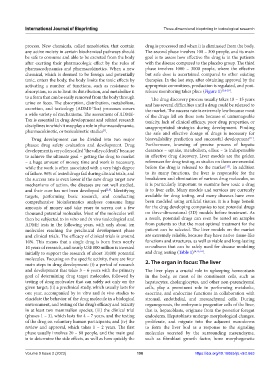Page 206 - IJB-9-2
P. 206
International Journal of Bioprinting Three-dimensional bioprinting in toxicological research
process. New chemicals, called xenobiotics, that contain drug is processed and when it is eliminated from the body.
any active moiety in certain biochemical pathways should The second phase involves 100 – 300 people, and its main
be safe to consume and able to be excreted from the body goal is to assess how effective the drug is in the patients
after exerting their pharmacologic effect by the rules of with the disease compared to the placebo group. The third
pharmacodynamics and pharmacokinetics. When a new phase involves 1000 – 3000 people, where the effective
chemical, which is deemed to be foreign and potentially but safe dose is ascertained compared to other existing
toxic, enters the body, the body limits the toxic effects by therapies. In the last step, after obtaining approval by the
activating a number of functions, such as resistance to appropriate committees, production is regulated, and post-
absorption, so as to limit its distribution, and metabolize it release monitoring takes place (Figure 1) [1,4-10] .
to a form that can be easily removed from the body through The drug discovery process usually takes 10 – 15 years
urine or feces. The absorption, distribution, metabolism, and has several difficulties until a drug could be released to
excretion, and toxicology (ADME-Tox) processes covers the market. The success rate is extremely low because most
a wide variety of mechanisms. The assessment of ADME- of the drugs fail on these tests because of unmanageable
Tox is essential in drug development and related research toxicity, lack of clinical efficacy, poor drug properties, or
disciplines in which it may play a role in pharmacodynamic, unappropriated strategies during development. Finding
pharmacokinetic, or toxicokinetic studies . the safe and effective dosage of drugs is necessary for
[1]
Drug development can be divided into two major bioavailability prediction and successful development .
[11]
phases: drug safety evaluation and development. Drug Furthermore, knowing of precise process of hepatic
development is very often called “the valley of death” because clearance – uptake, metabolism, efflux – is indispensable
to achieve the ultimate goal – getting the drug to market in effective drug discovery. Liver models are the golden
– a huge amount of money, time and work is necessary, references for drug testing, as studies on them are essential
[12]
while the work is often associated with a very high degree before the drug is released to the market . In addition
of failure. 96% of tested drugs fail during clinical trials, and to its many functions, the liver is responsible for the
the success rate is even lower if the new drugs target new breakdown and elimination of various drug molecules, so
mechanisms of action, the diseases are not well studied, it is particularly important to examine how toxic a drug
and their cure has not been developed yet [2,3] . Identifying is to liver cells. Many models and services are currently
targets, performing basic research, and conducting available for drug testing, and many diseases have even
comprehensive bioinformatics analyses consume large been modeled using artificial tissues. It is a huge benefit
amounts of money and take years to screen out a few for the drug developing companies to test potential drugs
thousand potential molecules. Most of the molecules will on three-dimensional (3D) models before treatment. As
then be subjected to in vitro and in vivo toxicological and a result, potential drugs can even be tested on samples
ADME tests in the following years, with only about ten from patients so that the most optimal treatment for the
molecules reaching the preclinical development phase patient can be selected. The liver models on the market
and clinical trials. The efficacy of clinical trials is around are extremely reliable, because they have native tissue-like
10%. This means that a single drug is born from nearly functions and structures, as well as viable and long-lasting
10 years of research, and nearly US$ 800 million is invested co-cultures that can be safely used for disease modeling
initially to support the research of about 10,000 potential and drug testing (Table 1) [4,13,14] .
molecules. Focusing on the specific activity, there are four
main steps in drug development: (i) a period of research 2. The organ in focus: The liver
and development that takes 3 – 6 years with the primary The liver plays a crucial role in upkeeping homeostasis
goal of determining drug target molecules, followed by in the body, as most of its constituent cells, such as
testing of drug molecules that can safely act only on the hepatocytes, cholangiocytes, and other non-parenchymal
given target; (ii) a preclinical study, which usually lasts for cells, play a prominent role in performing metabolic,
one year, accompanied by in vitro and in vivo studies to exocrine, and endocrine functions in collaboration with
elucidate the behavior of the drug molecule in a biological stromal, endothelial, and mesenchymal cells. During
environment, and testing of the drug’s efficacy and toxicity organogenesis, the embryonic progenitor cells of the liver,
in at least two mammalian species; (iii) the clinical trial that is, hepatoblasts, originate from the posterior foregut
(phases 1 – 3), which lasts for 4 – 7 years, and the testing endoderm. Hepatoblasts undergo morphological changes,
of the drug on voluntary human participants; and (iv) the proliferate, and migrate into the adjacent mesoderms
review and approval, which takes 1 – 2 years. The first to form the liver bud as a response to the signaling
phase usually involves 20 – 80 people, and the main goal molecules secreted by the surrounding mesenchyme,
is to determine the side effects, as well as how quickly the such as fibroblast growth factor, bone morphogenetic
Volume 9 Issue 2 (2023) 198 https://doi.org/10.18063/ijb.v9i2.663

